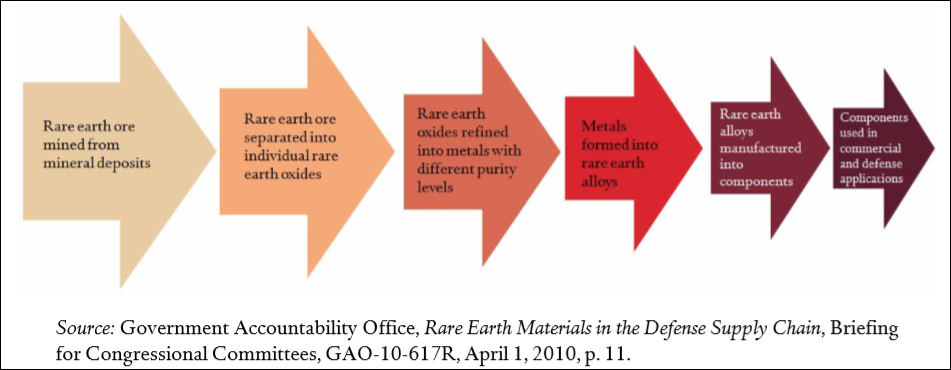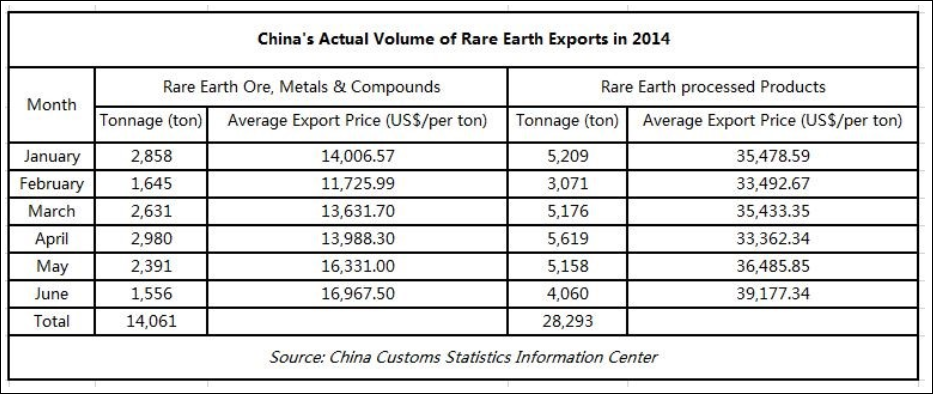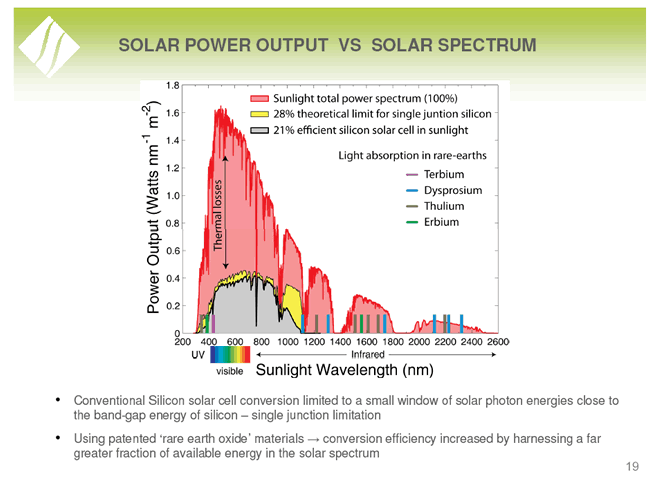What are Rare Earth Elements
Periodic Table

The REE group is considered to include the 15 lanthanide elements: lanthanum, cerium, praseodymium, promethium (does not occur naturally), neodymium, samarium, europium, gadolinium, terbium, dysprosium, holmium, erbium, thulium, ytterbium, and lutetium. The elements yttrium and scandium are also included as they have similar chemical properties, making 17 REEs in total. The resource and market details refer to REEs in the oxide form and the group is collectively discussed as Rare Earth Oxides (REO)
Processing and Production Stages for REE Materials

Interactive Google map showing Australian Rare Earth JORC Deposits
Rare Earth Elements - “Specialty Metals" for a Greener World
- The electric motor in a Toyota Prius uses about two pounds of neodymium in its permanent magnets.
- Each Prius battery also uses 20 to 30 pounds of another rare earth element, lanthanum.
- It takes about a ton of neodymium for every megawatt of generating capacity from wind turbines.
The information published below was supplied by Greenland Energy and Minerals
Rare Earth Elements (REEs) are a group of specialty metals with unique physical, chemical and light-emitting properties that are seeing dramatic increases in demand, owing to their technological applications. The unique properties of REEs make them critical materials to many emerging technologies which are becoming increasingly commonplace in today’s society. While global consumption has been steadily increasing, supply of REEs has tightened dramatically. For the last 10 years, China has dominated global supply, but owing to the importance of REE availability to internal industries, China is prioritizing its domestic markets through steadily increasing export taxes on REEs in tandem with reducing export quotas. As a result, REEs are in short supply, and with demand forecast to progressively increase, the world drastically needs new suppliers of REEs.
Rare Earth Elements - Supply and Demand

Over the last 10-15 years world consumption of REO has increased at 8-12% per annum, and in 2008 consumption is forecast to be in the order of 135,000 tonnes (1.5-2B US$). Global demand for REEs is already outweighing supply, resulting in sharp increases in their value. China currently contributes > 90% of global REE supply, and already consumes > 60%. In recent years the Chinese have been steadily reducing export quotas, and increasing export taxes, in recognition that REOs represent a very strategic commodity group. As with many commodities, the REE landscape is at a point of radical change. China is turning its priority from supplying the world, to supplying the burgeoning demand from internal industries that are dependent on REE availability. By 2012 global consumption of REEs is forecast to increase by 65% from current levels, driven by significant market growth for many applications that rely on REEs. As a result the world urgently needs new, long-term stable suppliers of REEs to meet the strong demand. Given that the major applications for REEs are products and devices that offer environmental benefits, the need to significantly increase REE supply is paramount to facilitating the emergence of new technologies that can help to preserve the world as we know it.

What are the Rare Earth Elements Used For
Most people are now familiar with hybrid vehicles, rechargeable batteries, mobile (cell) phones, plasma and LCD screens, laptop computers, disk drives and catalytic converters, but it is not widely known that these products, amongst many others, are dependent on the unique properties of Rare Earth Elements.
Rare Earth Elements make the world’s strongest permanent magnets. These magnets are utilized in electric motors to produce greater power and torque, and owing to the power of the magnets, less material is required such that engines can be considerably smaller and lighter in weight. Electric motors that utilize REEs are a key component of hybrid vehicles, which will become increasingly abundant on roads throughout the world in years to come. The powerful REE magnets also permit the miniaturisation of hard disk drives used in many electrical devices. Neodymium and dysprosium are the REEs with unique magnetic properties.
Many electronic products are powered by rechargeable batteries. One of the most effective rechargeable batteries is the nickel-metal hydride, or NiMH battery that is used in hybrid cars and many other electronic products. A mixed rare earth metal alloy is used as the anode in the NiMH battery, and makes up about 26% of the battery’s weight. Lanthanum is the main REE used in the NiMH battery.
A catalytic converter is a device fitted to the exhaust system of a combustion engine that reduces the toxicity of emissions. Such devices have been fitted to many automobiles in North America since the 1970s. Recent technological advances have seen the emergence of the three-way catalytic converter. This device reduces toxic nitrogen oxides to harmless nitrogen and oxygen, oxidizes toxic carbon monoxide to carbon dioxide, and additionally oxidizes unburnt hydrocarbons. Cerium is the REE used in catalytic converters, where it forms part of the catalyst. Tighter vehicle emission laws are being introduced throughout the world, and by 2010 it is predicted that 95% of all cars manufactured will have catalytic converters.
Rare Earth Elements are also used in another form of catalyst, commonly referred to as a fluid-cracking catalyst. These are being used increasingly in the oil industry as they enhance the efficiency of separating various fractions from oil during the refining process. Lanthanum is the main REE used in fluid cracking catalysts.
The use of REEs in magnets, rechargeable batteries and catalysts accounts for > 60% of REE consumption with demand expected to increase significantly in all these areas. References
Substitution
As consumers demand ever better products, the inquiry of the sustainability of the critical elements arises: how pressing is the necessity to begin developing alternative technologies or substitute substances? The fast evolution of widely used technology in recent years from sharper display screens, more powerful computers and smaller to smarter mobile phones and more efficient electric motors depend on rare earth metals and exotic elements for example tantalum and niobium. The issue was thrown into sharp focus by a complete new survey of the major uses of 62 metals as well as the functionality of substitutes, where they exist. The audit, carried out by by Thomas Graedel at Yale University, arrived at a stark decision: "For a dozen distinct metals, the potential substitutes because of their important uses are either inadequate or appear to not exist at all."

Are Rare Earths the same as Rare Metals?
- Minerals of critical concern
- China's attitude
- Interactive Map of Australia's JORC REE deposits
- Relative abundance Heavy - Light REEs selected deposits
- Current and future supplies
Rare Earths are part of a wider spectrum of Rare Metals. Rare metals include substances such as tantalum, niobium, gallium and some might include lithium. The Rare Earths are shown above.
Did you know that rare earths are part of the solar energy revolution?

Please note that this is a rapidly changing field and that the data contained will inevitably be out of date some of the time; meaning that you should not rely on it to make investment decisions and consequently you must do your own research.

 />
/>
